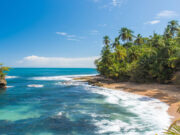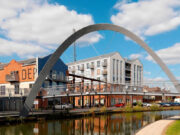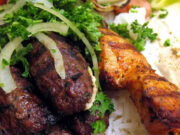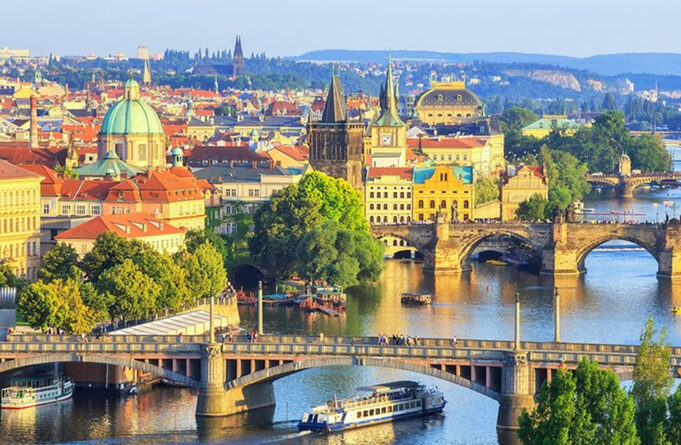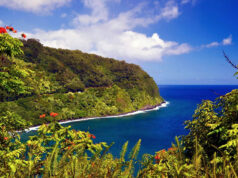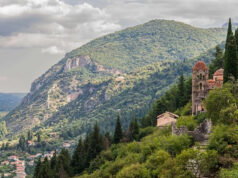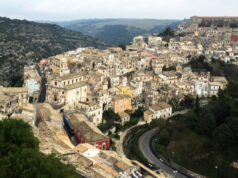Prague resident Jacy Meyer explores the unknown face of the capital of the Czech Republic and the spa towns beyond
We are entering a fairly shabby pasáž, or passageWay, just off one of the busiest streets in Prague’s new town quarter of Nové Mĕsto. Adam Gebrian, a self- described fan of architecture, is leading the charge through what feels like a company’s courtyard. then suddenly we are outside, in a square viewing the backsides of buildings. a sharp right turn and we are in – a garage. and then, out on the street again.
It has been a surreal shortcut from noisy, busy spálená to opatovická, a quieter street that winds around some of the best parts of the older section of nové Mĕsto, with its antiques shops, cafes and wine bars. it is seemingly hidden-but-visible places like this that get Adam excited about Prague.
“the most interesting and beautiful spaces are close to tourist spots but aren’t tourist spots,” says Adam, a trained architect who works independently on architecture-related projects. “you would think the better places used by locals were away from the centre, but that’s not true.”
Most people would not have independently taken the shortcut we just did, but pasáž like these are scattered across the city, mainly in the nové Mĕsto area. they were built at the beginning of the 20th century and are packed with beautiful architecture, but adam says most are only used as shortcuts by people who know about them. one of the best is located in the lucerna pasáž (www.lucerna.cz), off Vodičova street. there are three interlinked passages here, mainly art nouveau in style.
subtle and authentic
Look up when you are in the main hallway of the lucerna pasáž and dangling precariously overhead is a replica of the st. Wenceslas horse. a little altered by rebel Czech artist David Černý, this st. Wenceslas is astride an upside-down dead horse. head upstairs to the good but smoky café for a closer look.
By contrast, palác adria’s pasáž features a rondo-Cubism/italian renaissance motif with semicircular ornamentation and a portal with sculptures depicting the 12 signs of the zodiac.
“What’s great about Prague is that the area people visit is small, so it is easy to find some nice place right in the centre,” says adam. With many visitors to Prague leaving with a ‘been there, done that’ feel about the city, not many plan a return trip. strolling not that far off the rutted route of old town square-bridge-Castle, however, will show you a subtle, more authentic Prague.
In the Nové Mĕsto neighbourhood, adam recommends bohe(my) lounge & grill. it’s atop a fairly unattractive building on the corner of národní street. but it’s a secret oasis: completely outdoors, with wicker tables and chairs, and a tasty tapas menu. the problem is you have to negotiate a series of escalators through a department store to reach it.
“It’s an interesting building from the 1970s,” says adam. “after a reconstruction, it’s not so nice, but it has a fabulous rooftop terrace. people need to remember that the most beautiful attractions are the interiors, like st. nicholas Church in Malá strana. everyone knows it from the outside, but it’s more splendid inside – dynamic baroque – just incredible.”
Visitors looking to go where most tourists normally do not venture should head over to the holešovice area, a neighbourhood which adam says “feels like there is a lot of possibility.”
Jana tomášková is the artist coordinator for galerie Vernon (www.galerievernon. com), a private gallery in holešovice. the gallery’s team also coordinates tina b. (www.tina-b.eu), an annual contemporary arts festival, running this year from october 17-31. even if you can’t make it to prague for the festival, tina b. is arranging outdoor installations that will be on display throughout the winter. at the tV tower in žižkov (www.towerpark.cz), for example, there will be a golem installation by Czech-american artist shalom neuman and a pyramid made from plastic bottles.
“prague is quite diverse but the private galleries are in holešovice, the factory quarter,” says Jana. besides Vernon gallery, Vernon projekt is a 24-hour art installation in the window of a former shop (heemanova 12), while Dox (www.dox.cz) is one of the most exciting galleries in the city. housed in a former factory and sprawling across various buildings and levels, Dox has at least five different exhibits at any one time, featuring both local and international artists. nearby is the new creative complex osadní 35, which offers a number of private galleries, plus a café. for fine dining in the area, you won’t go far wrong with the asian sasaZu (www.sasazu.com), a Michelin bib gourmand restaurant. adam gebrian’s final piece of advice is simple and applies no matter where you go in the Czech republic. “the best cafes are on the first floor; the best pubs, underground,” he says.
seeking the cure for a different sort of exploration, head to the trio of spa towns northeast of prague: Karlovy Vary, Mariánské lázne and františkové lázne will give you a distinctive feel for the Czech republic.
“I have lived in Karlovy Vary all my life and in my view, the best thing is the location and size of the town. not too big, everything is near and all around is the countryside,” says Jarmila průšová.
Karlovy Vary is the Czech republic’s best known spa town, its thermal baths and drinking cures reputed to be beneficial in treating a host of ailments. the city’s golden years were in the 18th and 19th centuries, and most of the beautiful landmarks and colonnades date from this period. but while the destination is attractive, it is touristy and those looking to escape the masses may feel a little trapped. “the town is divided into two parts, one is the spa and the other the ‘civilian’,” says Jarmila. “i can recommend both. the spa part is mainly the colonnade with springs and hotels and restaurants, really just for tourists.” but sneak away from the colonnade section and you’ll find authenticity on the roads off t.g. Masaryka street. Jarmila recommends the Charleston restaurant (www.charleston-kv.cz), and sakura for sushi (www.sushisakura.cz). and do find time for a walk in the nearby woods.
“There are many trails in the forest,” says Jarmila, “and the best thing to see is a lookout tower called Diana (www.dianakv.cz); from here there is a beautiful view down to the town.” for a more relaxing visit to a spa town, check into a spa hotel in either Mariánské lázne or františkové lázne. in Mariánské lázne, a lovely park for strolling runs alongside the main street, with an impressive colonnade at the end. and in 2011, a new spa complex called Maria’s spa (www.marienbad.cz) opened, offering a unique experience using peat and Co2 gas in its treatments.
Meanwhile, františkové lázne is a bright yellow breath of fresh air, with its lovely spa houses and pavilions offering charm from the turn of the 19th century. nearby forests, parks and orchards make this a natural place to unwind, with three large parks surrounding the city centre.



